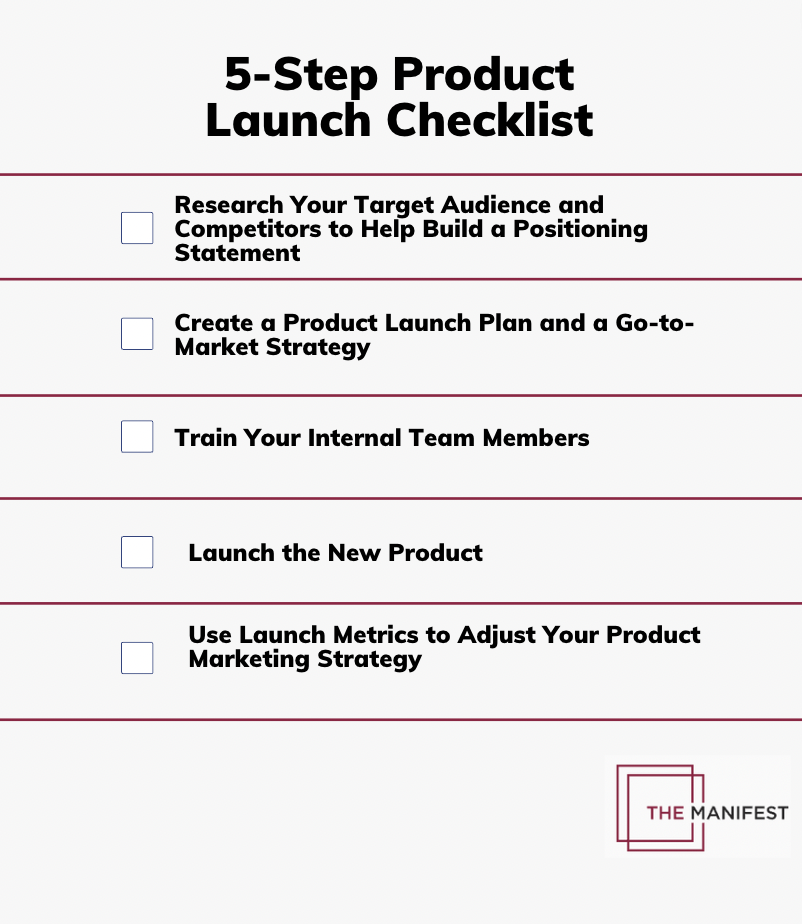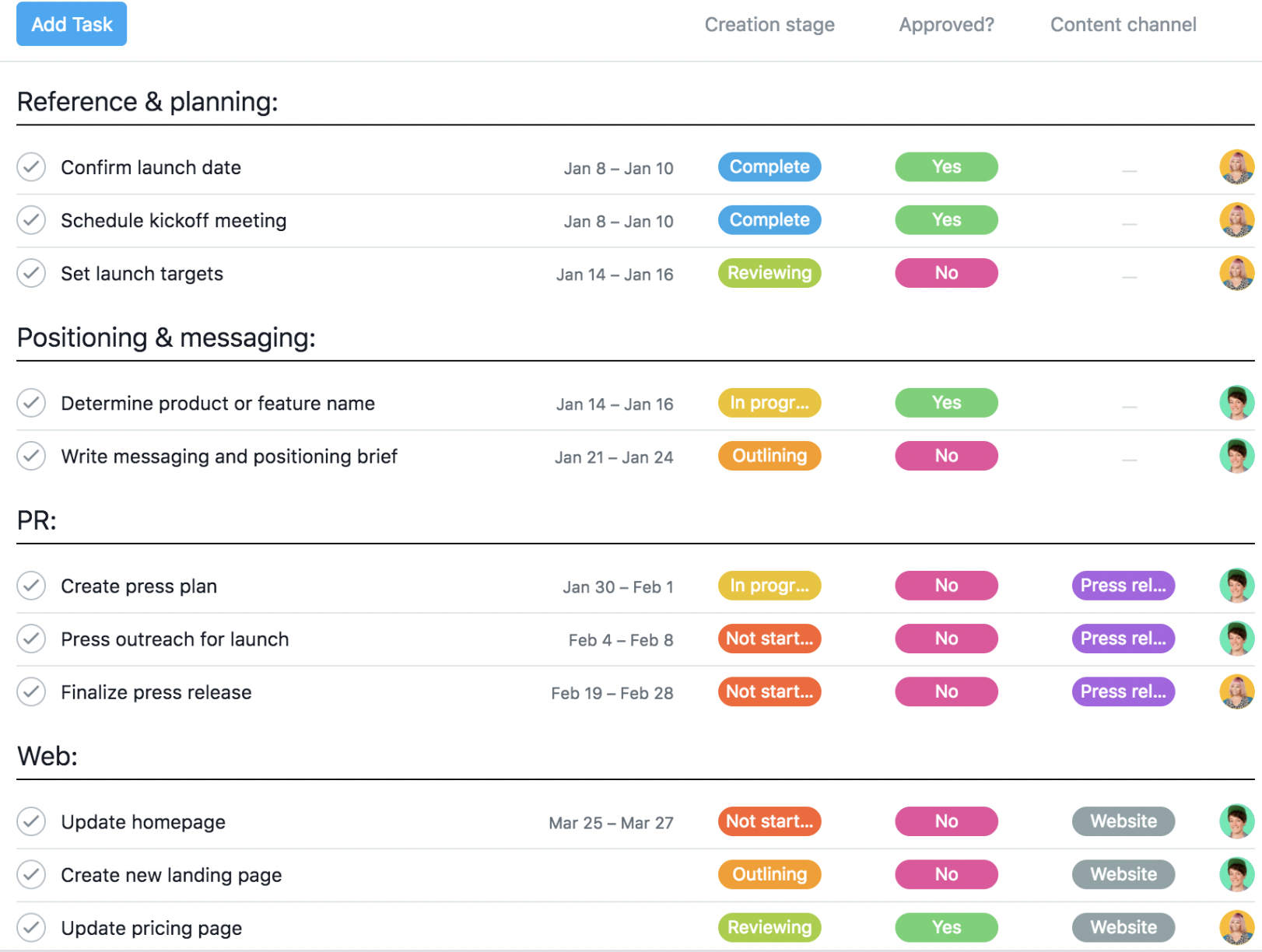Product Launch Checklist: Launch Software in 5 Steps

Product Launch Checklist: Launch Software in 5 Steps
Many businesses struggle against the challenge of smoothly launching a new software product. Intentional project management approaches paired with a go-to-market strategies and an informed team make for an ideal product launch environment. Follow our checklist to ensure a successful product launch.
Whether you run a startup or a well-established software firm, a new product launch can be one of the most stressful prospects for your company.
Statistics back up the anxious feelings that surround product launches. For instance, recent research from Gartner found that almost half of product launches are delayed by at least one month.
Additionally, the American Marketing Association has reported that only 40 percent of products make it to market and of those products, only 40 percent will be profitable.
The nerve-wracking nature of product launches may not initially make sense to you, though. Throughout the software development process, your product team has certainly built up the know-how necessary to understand your product itself fully.
However, understanding the product is only one part of a successful product launch checklist. To properly get ready to bring your product to market, your team will need to understand how to communicate its utility to your customer base effectively.
If your team is getting ready to release any new software, whether it be an entirely new app or new features for an existing software solution, you’ll want to ensure you’re prepared for your product launch day.
Need help launching your product? Hire a top software development team on The Manifest.
What is a Product Launch?
To understand the steps in a successful product launch, we first need to review what a product launch is.
A product launch is a coordinated effort by multiple functional teams within your business to generate interest in a new product or feature, bring the product or feature to market, and get customers to buy the product or feature.
Falling at the end of the product development process, the product launch should be led by a product manager. This team member will ensure that all departments understand what is expected of them throughout the product launch process, increasing efficiency and ensuring a cohesive brand message.
Product Launch: Soft Launch vs. Hard Launch
In the software world, there are two main types of product launches: soft launches and hard launches.
A soft launch is the release of a finished product ahead of schedule to a limited audience with a minimal marketing push.
With software and app success tied so directly to customer feedback, soft launches allow product teams to conduct real-world testing of a small segment of their overall user base prior to a major release.
When envisioning successful soft launches, the soft launch of Pokémon GO should be one of the first to come to mind.

Source: Pokemon Go Live
On July 6, 2016, publisher Niantic released the mobile game app in three countries (Australia, New Zealand, and the United States) before its worldwide release to ensure the server capacity and monetization structure would function correctly while increasing anticipation of the full launch.
A hard launch, on the other hand, is a full release of a product to your target audience after all testing has been conducted and the product is entirely ready to go to market.
These more conventional launches allow established businesses with a well-known product line to turn the fanfare of the full launch into a high volume of sales over a short period.
Apple has a reputation for administering successful hard launches, with the iPhone 6 and 6 Plus selling over 10 million units and the iPhone 6s and 6s Plus selling approximately 13 million units during the weekends following each release.

Source: Apple
With an understanding of what a product launch is as well as the different types of product launches, we can discuss the steps that make up a successful product launch checklist.
Product Launch Checklist: A 5-Step Template for a Successful Product Launch
Building a strong product launch strategy may seem like a difficult challenge. However, you can guide your team to a successful product launch by following the 5 steps listed below:
- Research Your Target Audience and Competitors to Help Build a Positioning Statement
- Create a Product Launch Plan and a Go-to-Market Strategy
- Train Your Internal Team Members
- Launch the New Product
- Use Launch Metrics to Adjust Your Product Marketing Strategy

Looking for a more in-depth overview of the product launch process? Read on to find out more.
1. Research Your Target Audience and Competitors to Help Build a Positioning Statement
One of the most important components of a successful product launch is an insightful product positioning statement. A positioning statement comprises a brief description of your product and an explanation of how it meets the needs of your target market.
Your new product’s positioning statement should answer the following questions:
- Who does the product serve?
- What value does the product offer?
- How does this value fit into the overall landscape of the marketplace?
- Why is this product a part of your product suite?
- What makes the product different from those of competitors?
Conducting market research that takes both your target market as well as any direct competitors you may face into consideration is key to developing a compelling positioning statement.
When researching your competitors, try to gauge the pricing and functionality of similar software to yours to pinpoint any key differences between the product you’ll be launching and the existing solutions.
Similarly, customer research should be designed to find out what customers within your target audience expect of products like yours as well as any pain points that arise with current solutions.
Your findings about your customers in these areas should highlight the expectations and desires they will bring to your product when it is launched.
Additionally, your findings about your competitors should highlight how your product is different from existing solutions.
Uncovering these findings will help you and your team create a positioning statement that can easily be aligned with your target marketplace in a way that makes your product stand out.
This statement will help shape each of the following steps in this checklist and will remain central to the brand messaging surrounding the product you’re launching.
Before finalizing your positioning statement and moving forward with your product launch process, you and your team should present the statement to key stakeholders.
This presentation will ensure that your team understands the product’s value proposition aligns with stakeholder expectations. It should also provide a space to address any stakeholder concerns about the product long before it is launched.
2. Create a Product Launch Plan and a Go-to-Market Strategy
Once you’ve generated a well-thought-out positioning statement for your new product, you and your team should work together to create a comprehensive product launch plan.
A product launch plan is a document that lays out all steps needed to get your product ready for its launch date and the timeline in which these steps should be completed. It should serve as a roadmap for your product launch strategy. You can use project management tools like Asana to create these.

Source: Asana
Devising the product launch plan will require input from several teams within your business. For example, the product development team should identify which documentation, such as release notes, they’ll need to compile and deliver before launch.
Updating your company website to support the product launch should also be a part of the product launch plan. Your customer service team may want to publish FAQs for your new product, and your web design team should add and update any e-commerce and landing pages on your site to support the new product.
Your product launch plan should also incorporate ideas from your marketing team about the go-to-market strategy for the product launch. A go-to-market strategy is a step-by-step marketing plan that outlines any necessary actions to bring a new product to market.
The go-to-market strategy should dictate which marketing channels will be used to publicize the product launch and how the channels will be used. It will set forth an overarching social media strategy and dictate when and how press releases should be structured.
In particular, the go-to-market strategy should draw influence from the customer research conducted earlier in the product launch process.
Marketing is about building relationships with existing and new customers, so understanding the perspectives and desires of your target audience will be a game changer for your go-to-market strategy and, in turn, your overall product launch plan.
3. Train Your Internal Team Members
People often associate the phrase “product launch activities” with external promotion activities such as social media campaigns or internal preparation activities such as server and website configuration.
However, any successful product launch checklist should account for time spent training your internal team members to support the launch of the new software.
Your company’s product team and marketing team will certainly have firsthand experience with your new product at this point in the product launch process.
Your other teams will need to be up to speed on their role in helping this product succeed, though.
For instance, your sales team will need to understand what the new product does, how it fits into your existing product suite, and what the target audience’s characteristics are.
Similarly, your customer support team should be briefed on what they need to do to support the target user base for the new product. Depending on how intensive the software is, they may decide to take actions such as developing tutorials to help customers acclimate themselves.
A great exercise to help your team more effectively understand the end user’s perspective in any product launch training activities is creating buyer personas. These are fictionalized versions of your ideal customers in each market segment that can be used when considering a user’s motivations concerning your new product.
4. Launch Your New Product
The most important part of the product launch checklist is the actual product release.
Your launch date should serve as the culmination of all of you and your team’s hard work in getting the new product ready for public use up to this point.
All preparatory actions in the product launch plan such as developing the software, running promotional marketing campaigns, and setting up a hosting service will have occurred at this point.
Now, the public can begin to use your product and provide you with feedback.
5. Use Launch Metrics to Tweak Your Software and Adjust Your Product Marketing Strategy
Up to this point, we’ve discussed pre-launch activities for launching new software products. Yet, it’s important to note that your product launch checklist shouldn’t conclude after the product is launched.
Rather, it should include post-launch activities designed to better your new product with any findings that come after it has been launched.
One such activity would be tracking and analyzing metrics related to the product launch to help better the marketing and functionality of the new product and gain insight on how to improve future product launches.
Quantitative Metrics
Quantitative metrics will be an important barometer for product launch success. For example, if your new product is web-based, analyzing site conversion data can help you and your team gauge the product's performance in the marketplace. Statistics such as these can be pulled in real-time using software such as Google Analytics.
Qualitative Feedback
While quantitative data is important, qualitative feedback shouldn’t be overlooked either. This would include customer reviews and testimonials about the new product. These sources can specifically indicate which features of the software are well-received and which ones could use improvement.
These findings should be reviewed regularly after the product launch date and used to make changes to the new product as necessary to improve its performance in the marketplace. Any discoveries about the buyer personas within your company’s target audience or other high-level factors can also be used to shape future product launch strategies.
A Comprehensive Product Launch Checklist Can Help New Products Succeed
While product launches can be intimidating for businesses of any size, relying on a carefully-considered product launch checklist will make the time leading up to and following the launch as easy as possible.
You’ll want to make sure your checklist includes researching your target audience and competitors, building a positioning statement, creating a product launch plan and go-to-market strategy, training your internal team members, launching your new product, and using launch metrics to tweak your software and adjust your product marketing strategy.
Incorporating these activities into your product launch process will ensure that you and your team properly prepare to bring your new product to market and will give your software the best chance of success with your target user base.
Connect with the best software developers on The Manifest.
Additional Reading:
